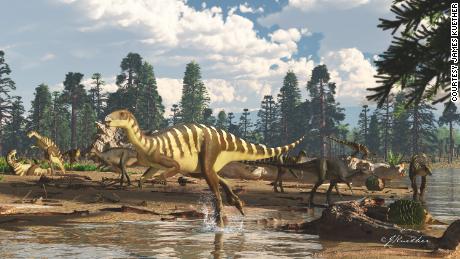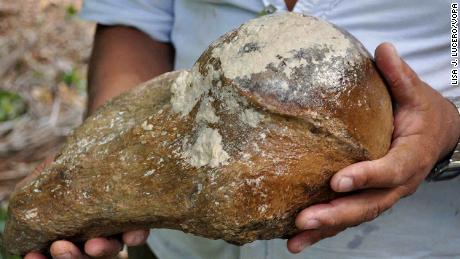Giant fossil found in Kenya’s museum

Portions of the animal's jaw, skull and skeleton, including enormous teeth, were discovered in a drawer at the National Museums of Kenya. The fossils were originally found in Kenya decades ago and thought to be a smaller species, but those researchers were searching for ancient apes, so the fossils were put aside."Opening a museum drawer, we saw a row of gigantic meat-eating teeth, clearly belonging to a species new to science," said Matthew Borths, study author and curator of the Division of Fossil Primates at Duke University, in a statement. The skull is comparable to that of a rhinoceros, and given its size and giant sharp teeth, the carnivore was at the head of its food chain. The researchers estimate that it weighed 1.6 tons and could prey on large herbivores akin to today's elephant and hippopotamus. The fossilsof this 'ancient lion' are described in a study published Thursday in the Journal of Vertebrate Paleontology. Its canine teeth and molars would have been able to tear flesh and crack bones easily, but the teeth on this particular specimen aren't very worn, suggesting that it was younger. Despite its young age, the animal's jaw is much larger when compared to that of a modern adult male lion. The researchers dubbed the newly discovered species Simbakubwa kutokaafrika, which is Swahili for "big lion coming from Africa." But it's not a close relative of lions, other big cats or even mammalian carnivores that roam the Earth today. Instead, Simbakubwa was part of the hyaenodonts, an extinct group of mammalian carnivores that lived in Africa. And Simbakubwa is the oldest of this group, making it one of the largest carnivorous mammals ever to live on land.After the extinction of dinosaurs, they enjoyed a 45 million-year reign as the key predators. But tectonic plates shifted, introducing animals from other landmasses like the relatives of dogs, cats and hyenas. This allowed Simbakubwa to cross a landbridge into Eurasia and flourish on other continents, as well.
The researchers dubbed the newly discovered species Simbakubwa kutokaafrika, which is Swahili for "big lion coming from Africa." But it's not a close relative of lions, other big cats or even mammalian carnivores that roam the Earth today. Instead, Simbakubwa was part of the hyaenodonts, an extinct group of mammalian carnivores that lived in Africa. And Simbakubwa is the oldest of this group, making it one of the largest carnivorous mammals ever to live on land.After the extinction of dinosaurs, they enjoyed a 45 million-year reign as the key predators. But tectonic plates shifted, introducing animals from other landmasses like the relatives of dogs, cats and hyenas. This allowed Simbakubwa to cross a landbridge into Eurasia and flourish on other continents, as well.  "Read More – Source
"Read More – Source
[contf] [contfnew] 
CNN
[contfnewc] [contfnewc]



